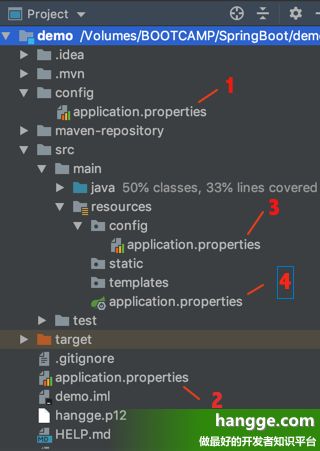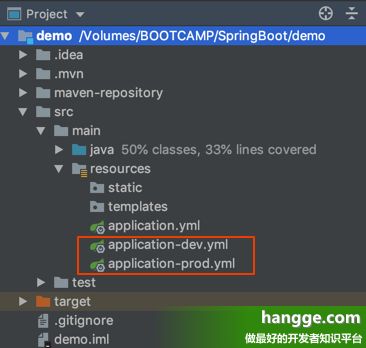SpringBoot - 配置文件application.yml使用详解(附:Profile多环境配置)
https://www.hangge.com/blog/cache/detail_2459.html
1,基本介绍
(1)YAML 是 JSON 的超集,简洁而强大,是一种专门用来书写配置文件的语言,可以替代 application.properties。
(2)在创建一个 SpringBoot 项目时,引入的 spring-boot-starter-web 依赖间接地引入了 snakeyaml 依赖, snakeyaml 会实现对 YAML 配置的解析。
(3)YAML 的使用非常简单,利用缩进来表示层级关系,并且大小写敏感。
2,YAML 配置与 Properties 配置的比较
- 可以使用 @PropertySource 注解加载自定义的 Properties 配置文件,但无法加载自定义的 YAML 文件。
- YAML 支持列表的配置,而 Properties 不支持。
3,常规配置
(1)在 Spring Boot 项目中使用 YAML 只需要在 resources 目录下创建一个 application .yml 文件即可,这里我们添加如下配置:
有了 application .yml 后我们可以将 resources 目录下的 application.properties 文件删除(当然保留也没问题),完全使用 YAML 完成文件的配置。
server:
port: 8081
servlet:
context-path: /hangge
tomcat:
uri-encoding: utf-8
- 其等效于 application.properties 中的如下配置:
server.port=8081 server.servlet.context-path=/hangge server.tomcat.uri-encoding=utf-8
(2)配置属性之间也可以相互引用使用:
my:
name: 航歌
age: 100
info: name:${my.name} age:${my.age}
(3)配置文件中可以使用 ${random} 来生成各种不同类型的随机值:
my:
secret: ${random.value}
number: ${random.int}
bignumber: ${random.long}
uuid: ${random.uuid}
lessthanten: ${random.int(10)}
numberinrange: ${random.int[1024,65536]}
4,将数据注入到属性上
(1)假设我们有如下配置数据:
my: name: 航歌 age: 100
(2)在需要的地方我们使用 @Value 注解就可以将数据注入到属性上:
| 1 2 3 4 5 6 7 8 9 10 11 12 13 14 15 16 |
|
(3)运行结果如下:
5,将数据注入到 Bean 中
有时候属性太多了,一个个绑定到属性字段上太累,官方提倡绑定一个对象的 bean。
(1)首先我们创建一个名为 My 的 Bean,并将前面的配置数据注入到这个 Bean 中。
(1)@ConfigurationProperties 中的 prefix 属性描述了要加载的配置文件的前缀。
(2)Spring Boot 采用了一种宽松的规则来进行属性绑定:
- 假设 Bean 中的属性名为 authorName,那么配置文件中的属性可以是 my.author_name、my.author-name、my.authorName 或者 my.AUTHORNAME
| 1 2 3 4 5 6 7 8 9 10 11 12 13 14 15 16 17 18 19 20 21 22 23 24 25 26 27 |
|
(2)然后我们在 Controller 中引入这个 Bean 使用即可:
| 1 2 3 4 5 6 7 8 9 10 11 12 13 14 15 16 |
|
(3)运行结果如下:
6,将数据注入到一个集合中
(1)YAML 还支持列表的配置:
my:
name: 航歌
favorites:
- 足球
- 篮球
- 排球
(2)下面同样将这组配置注入到 Bean 中,注意到其中 favorites 这个集合数据也自动注入到 List 属性中:
| 1 2 3 4 5 6 7 8 9 10 11 12 13 14 15 16 17 18 19 20 21 22 23 24 25 26 27 28 29 |
|
(3)然后我们在 Controller 中引入这个 Bean 使用即可:
| 1 2 3 4 5 6 7 8 9 10 11 12 13 14 15 16 |
|
(4)运行结果如下:
7,更复杂的配置:集合里面放置对象
(1)YAML 还支持更复杂的配置,即集合中也可以是一个对象:
my:
users:
- name: 大李
age: 100
- name: 小刘
age: 200
(2)下面同样将这组配置注入到 Bean 中:
| 1 2 3 4 5 6 7 8 9 10 11 12 13 14 15 16 17 18 19 |
|
| 1 2 3 4 5 6 7 8 9 10 11 12 13 14 15 16 17 18 19 20 21 22 |
|
(3)然后我们在 Controller 中引入这个 Bean 使用即可:
| 1 2 3 4 5 6 7 8 9 10 11 12 13 14 15 16 17 18 19 20 |
|
(4)运行结果如下:
8,使用命令行参数进行配置
(1)在命令行中通过 java -jar 命令启动项目时,可以使用连续的两个减号 -- 对 application.yml 中的属性值进行赋值。
(2)比如下面命令修改 tomcat 端口号为 8081。其等价于在 application.yml 中添加属性 server.port=8081:
注意:如果 application.yml 中已经有同名属性,那么命令行属性会覆盖 application.yml 的属性。
| 1 |
|
9,配置文件的优先级
(1)同 application.properties 文件一样,Spring Boot 项目中的 application.yml 配置文件一共可以出现在如下 4 个位置(优先级逐渐降低):
- 项目根目录下的 config 文件夹
- 项目根目录下
- classpath 下的 config 文件夹
- classpath 下
(2)如果这 4 个地方都有 application.yml 文件,加载的优先级就是从 1 到 4 依次降低,Spring Boot 将按照这个优先级查找配置信息。
附:使用 Profile 实现多环境配置
我们在项目发布之前,一般需要频繁地在开发环境、测试环境以及生产环境之间进行切换,这个时候大量的配置需要频繁更改(比如数据库配置、redis 配置、mongodb 配置等等)。
Spring Boot 的 Profile 就给我们提供了解决方案,它约定不同环境下的配置文件名称规则为:
- application-{profile}.yml,其中 {profile} 表示当前环境的名称。
1,创建配置文件
(1)首先在 resources 目录下创建两个配置文件:application-dev.yml 和 application-prod.yml 此时,分别表示开发环境中的配置和生产环境中的配置。
(2)它们两个分别设置不同的端口号。
| 1 2 3 4 5 6 7 |
|
2,在 application.yml 中配置环境
(1)假设我们在 application.yml 中进行如下配置,则表示使用 application-dev.yml 配置文件启动项目。
spring:
profiles:
active: dev
(2)如果将 dev 改为 prod,则表示使用 application-prod.properties 启动项目。
spring:
profiles:
active: prod
(3)项目启动成功后,就可以通过相应的端口进行访问了。
3,在代码中配置环境
(1)除了像前面那样在 application.yml 中添加配置,我们也可以在代码中添加配置来完成。
(2)比如我们在启动类的 main 方法上添加如下代码,表示使用 application-dev.yml 配置文件启动项目。
| 1 2 3 4 5 6 7 8 9 10 11 12 13 14 15 |
|
4,在项目启动时配置环境
我们也可以在项目打包成 jar 包后启动时,在命令行中动态指定当前环境:
| 1 |
|
原文出自:www.hangge.com 转载请保留原文链接:https://www.hangge.com/blog/cache/detail_2459.html





